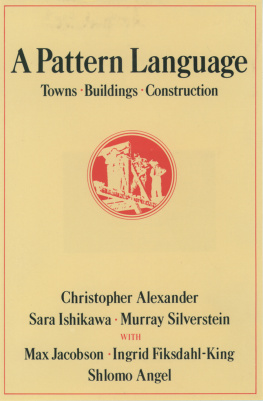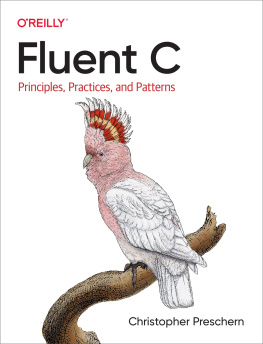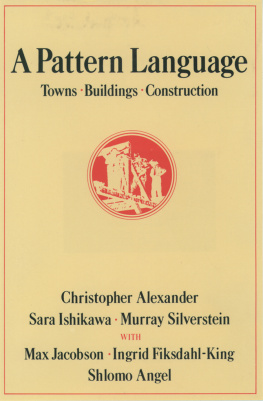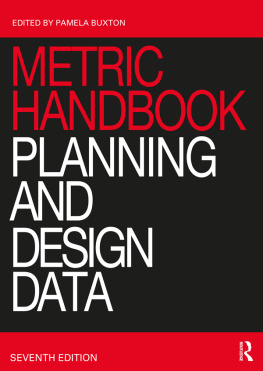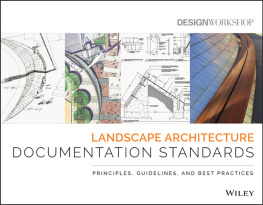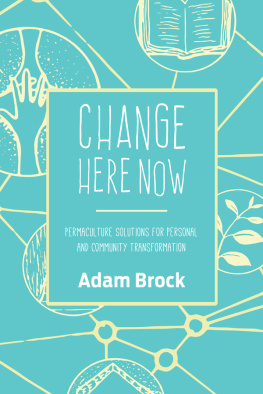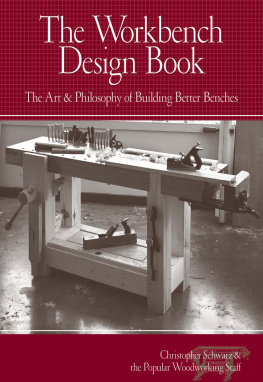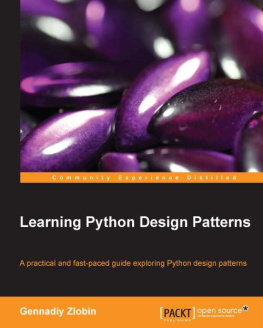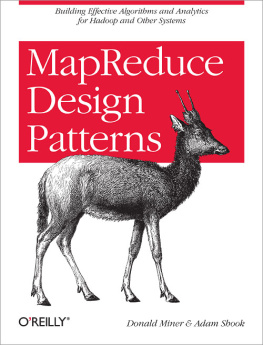A PATTERN LANGUAGE
TOWNS BUILDINGS CONSTRUCTION
A Pattern Language is the second in a series of books which describe an entirely new attitude to architecture and planning. The books are intended to provide a complete working alternative to our present ideas about architecture, building, and planningan alternative which will, we hope, gradually replace current ideas and practices.
volume I THE TIMELESS WAY OF BUILDING
volume 2 A PATTERN LANGUAGE
volume 3 THE OREGON EXPERIMENT
Center for Environmental Structure
BERKELEY, CALIFORNIA
Copyright 1977 by Christopher Alexander
Library of Congress Catalogue Card Number: 74-22874
ISBN 0-19-501919-9
CONTENTS
Volume 1, The Timeless Way of Building, and Volume 2, A Pattern Language, are two halves of a single work. This book provides a language, for building and planning; the other book provides the theory and instructions for the use of the language. This book describes the detailed patterns for towns and neighborhoods, houses, gardens, and rooms. The other book explains the discipline which makes it possible to use these patterns to create a building or a town. This book is the sourcebook of the timeless way; the other is its practice and its origin. The two books have evolved very much in parallel.
They have been growing over the last eight years, as we have worked on the one hand to understand the nature of the building process, and on the other hand to construct an actual, possible pattern language. We have been forced by practical considerations, to publish these two books under separate covers; but in fact, they form an indivisible whole. It is possible to read them separately. But to gain the insight which we have tried to communicate in them, it is essential that you read them both.
The Timeless Way of Building describes the fundamental nature of the task of making towns and buildings. It is shown there, that towns and buildings will not be able to become alive, unless they are made by all the people in society, and unless these people share a common pattern language, within which to make these buildings, and unless this common pattern language is alive itself.
In this book, we present one possible pattern language, of the kind called for in The Timeless Way. This language is extremely practical. It is a language that we have distilled from our own building and planning efforts over the last eight years. You can use it to work with your neighbors, to improve your town and neighborhood. You can use it to design a house for yourself, with your family; or to work with other people to design an office or a workshop or a public building like a school. And you can use it to guide you in the actual process of construction.
The elements of this language are entities called patterns. Each pattern describes a problem which occurs over and over again in our environment, and then describes the core of the solution to that problem, in such a way that you can use this solution a million times over, without ever doing it the same way twice.
For convenience and clarity, each pattern has the same format. First, there is a picture, which shows an archetypal example of that pattern. Second, after the picture, each pattern has an introductory paragraph, which sets the context for the pattern, by explaining how it helps to complete certain larger patterns. Then there are three diamonds to mark the beginning of the problem. After the diamonds there is a headline, in bold type. This headline gives the essence of the problem in one or two sentences. After the headline comes the body of the problem. This is the longest section. It describes the empirical background of the pattern, the evidence for its validity, the range of different ways the pattern can be manifested in a building, and so on. Then, again in bold type, like the headline, is the solutionthe heart of the patternwhich describes the field of physical and social relationships which are required to solve the stated problem, in the stated context. This solution is always stated in the form of an instructionso that you know exactly what you need to do, to build the pattern. Then, after the solution, there is a diagram, which shows the solution in the form of a diagram, with labels to indicate its main components.
After the diagram, another three diamonds, to show that the main body of the pattern is finished. And finally, after the diamonds there is a paragraph which ties the pattern to all those smaller patterns in the language, which are needed to complete this pattern, to embellish it, to fill it out.
There are two essential purposes behind this format. First, to present each pattern connected to other patterns, so that you grasp the collection of all 253 patterns as a whole, as a language, within which you can create an infinite variety of combinations. Second, to present the problem and solution of each pattern in such a way that you can judge it for yourself, and modify it, without losing the essence that is central to it.
Let us next understand the nature of the connection between patterns.
The patterns are ordered, beginning with the very largest, for regions and towns, then working down through neighborhoods, clusters of buildings, buildings, rooms and alcoves, ending finally with details of construction.
This order, which is presented as a straight linear sequence, is essential to the way the language works. It is presented, and explained more fully, in the next section. What is most important about this sequence, is that it is based on the connections between the patterns. Each pattern is connected to certain larger patterns which come above it in the language; and to certain smaller patterns which come below it in the language. The pattern helps to complete those larger patterns which are above it, and is itself completed by those smaller patterns which are below it.
Thus, for example, you will find that the pattern ACCESSIBLE GREEN (60), is connected first to certain larger patterns: SUBCULTURE BOUNDARY (13), IDENTIFIABLE NEIGHBORHOOD (14), WORK COMMUNITY (41), and QUIET BACKS (59). These appear on its first page. And it is also connected to certain smaller patterns: POSITIVE OUTDOOR SPACE (107), TREE PLACES (171), and GARDEN WALL (173). These appear on its last page.
What this means, is that IDENTIFIABLE NEIGHBORHOOD , SUBCULTURE BOUNDARY , WORK COMMUNITY, and QUIET BACKS are incomplete, unless they contain an ACCESSIBLE GREEN; and that an ACCESSIBLE GREEN is itself incomplete, unless it contains POSITIVE OUTDOOR SPACE, TREE PLACES , and a GARDEN WALL .
And what it means in practical terms is that, if you want to lay out a green according to this pattern, you must not only follow the instructions which describe the pattern itself, but must also try to embed the green within an IDENTIFIABLE NEIGHBORHOOD or in some SUBCULTURE BOUNDARY , and in a way that helps to form QUIET BACKS; and then you must work to complete the green by building in some POSITIVE OUTDOOR . SPACE, TREE PLACES , and a GARDEN WALL .
In short, no pattern is an isolated entity. Each pattern can exist in the world, only to the extent that is supported by other patterns: the larger patterns in which it is embedded, the patterns of the same size that surround it, and the smaller patterns which are embedded in it.
This is a fundamental view of the world. It says that when you build a thing you cannot merely build that thing in isolation, but must also repair the world around it, and within it, so that the larger world at that one place becomes more coherent, and more whole; and the thing which you make takes its place in the web of nature, as you make it.

